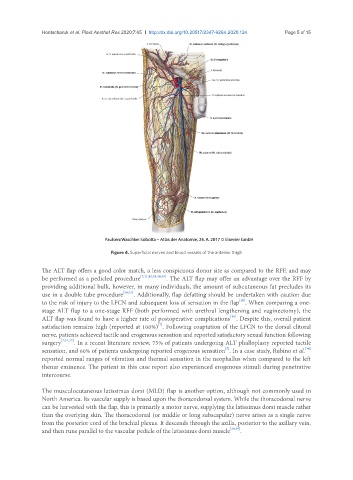Page 768 - Read Online
P. 768
Hontscharuk et al. Plast Aesthet Res 2020;7:65 I http://dx.doi.org/10.20517/2347-9264.2020.124 Page 5 of 15
Figure 4. Superficial nerves and blood vessels of the anterior thigh
The ALT flap offers a good color match, a less conspicuous donor site as compared to the RFF, and may
be performed as a pedicled procedure [7,11,20,21,34,35] . The ALT flap may offer an advantage over the RFF by
providing additional bulk, however, in many individuals, the amount of subcutaneous fat precludes its
use in a double tube procedure [20,21] . Additionally, flap defatting should be undertaken with caution due
[20]
to the risk of injury to the LFCN and subsequent loss of sensation in the flap . When comparing a one-
stage ALT flap to a one-stage RFF (both performed with urethral lengthening and vaginectomy), the
[36]
ALT flap was found to have a higher rate of postoperative complications . Despite this, overall patient
satisfaction remains high (reported at 100%) . Following coaptation of the LFCN to the dorsal clitoral
[7]
nerve, patients achieved tactile and erogenous sensation and reported satisfactory sexual function following
surgery [7,34,37] . In a recent literature review, 75% of patients undergoing ALT phalloplasty reported tactile
[7]
[34]
sensation, and 60% of patients undergoing reported erogenous sensation . In a case study, Rubino et al.
reported normal ranges of vibration and thermal sensation in the neophallus when compared to the left
thenar eminence. The patient in this case report also experienced erogenous stimuli during penetrative
intercourse.
The musculocutaneous latissimus dorsi (MLD) flap is another option, although not commonly used in
North America. Its vascular supply is based upon the thoracodorsal system. While the thoracodorsal nerve
can be harvested with the flap, this is primarily a motor nerve, supplying the latissimus dorsi muscle rather
than the overlying skin. The thoracodorsal (or middle or long subscapular) nerve arises as a single nerve
from the posterior cord of the brachial plexus. It descends through the axilla, posterior to the axillary vein,
and then runs parallel to the vascular pedicle of the latissimus dorsi muscle [38,39] .

